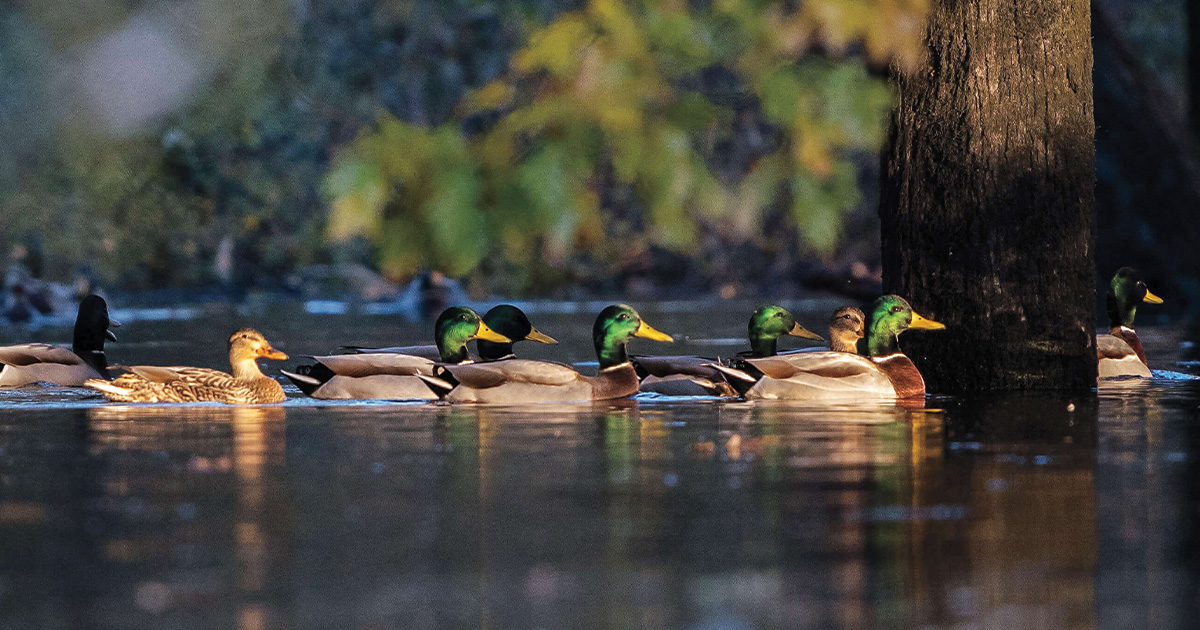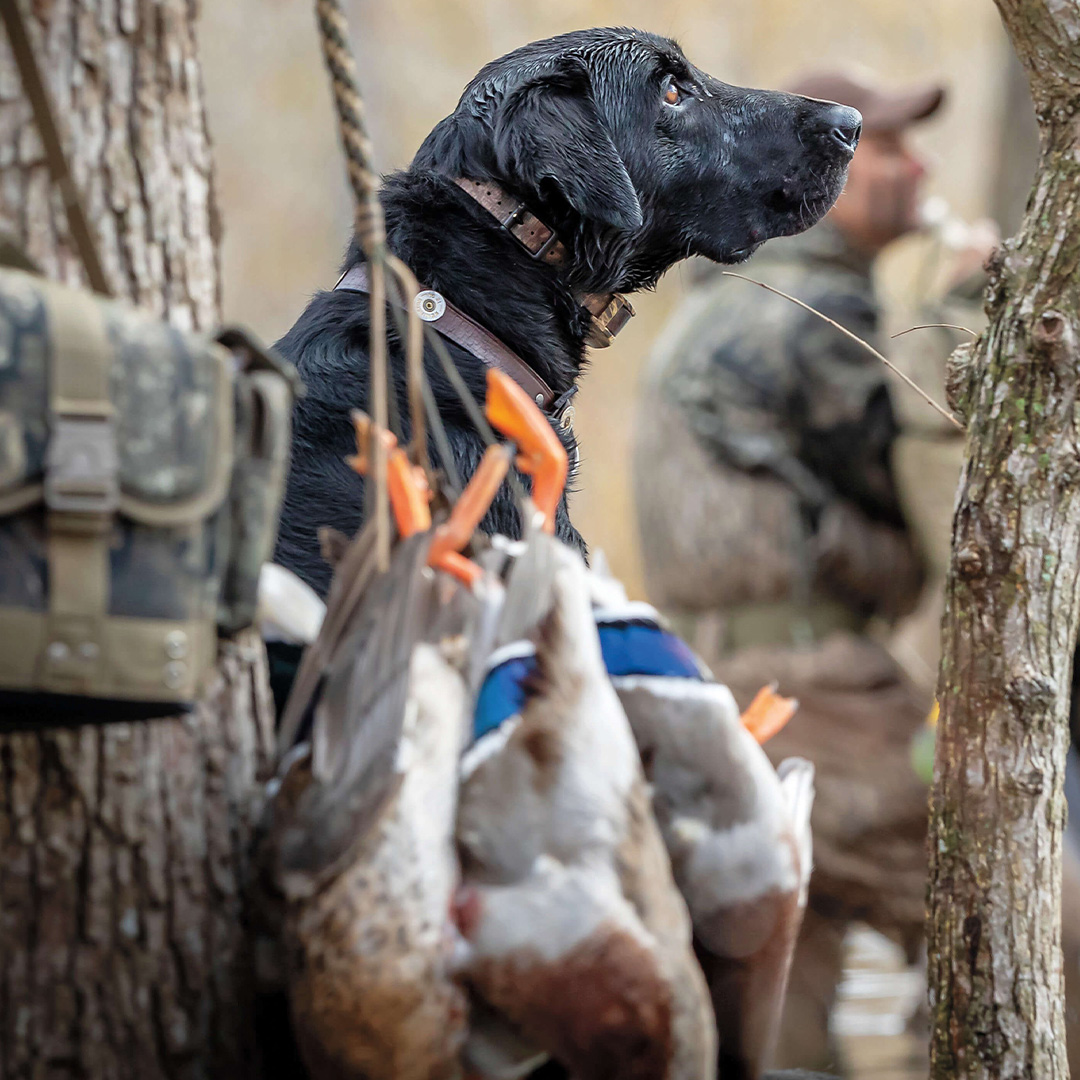Understanding Waterfowl: Treasures in the Timber
Crucial to waterfowl and other migratory birds, bottomland hardwood forests are among the world's most biologically diverse ecosystems
Crucial to waterfowl and other migratory birds, bottomland hardwood forests are among the world's most biologically diverse ecosystems
By Aaron Pierce, PhD, and Anne Mini, PhD

There is nothing quite like the sight of ducks dropping into flooded timber on a clear winter morning. Mallards, wood ducks, and many other waterfowl species flock to seasonally flooded bottomland hardwood forests for good reason. In fall and winter, these iconic habitats are rich in waterfowl food resources, including acorns, moist-soil plant seeds, and invertebrates. During spring and summer, these same woodlands support breeding wood ducks and hooded mergansers, which nest in tree cavities and raise their broods in scrub-shrub wetlands.
Bottomland hardwood forests are primarily found in riverine floodplains in the southern United States, including portions of the Piedmont, Gulf Coastal Plain, and Mississippi Alluvial Valley (MAV). These forested wetlands, which experience alternating wet and dry periods throughout the year, owe much of their productivity to fertile sediments and nutrients deposited during periods of seasonal flooding. They are home to a remarkable amount of biological diversity, supporting an abundance of wildlife in addition to waterfowl, such as white-tailed deer, black bears, wild turkeys, and numerous neotropical songbirds. When flooded, bottomland hardwood forests also serve as crucial spawning grounds for many species of fish, and these woodlands provide many other important nature-based services for people and wildlife, including clean water, flood mitigation, groundwater recharge, nutrient cycling, and carbon sequestration.
Most of the bottomland hardwood forests in the United States lie within the MAV, a 24-million-acre region spanning portions of seven states in the historic floodplain of the Mississippi River. Some 8 million acres of bottomland hardwood forests remain in the region, but much of this habitat has been degraded by changes to historical flooding regimes. For more than three decades, DU has worked with government agencies, private landowners, foundations, and other partners to help restore, enhance, and protect bottomland hardwood forests in the MAV and other important areas for waterfowl. To date DU and its partners have completed more than 15,500 projects in the MAV, conserving over 1.8 million acres of waterfowl habitat, including numerous tracts of bottomland hardwood forest. While many federal programs support these efforts, the most important is the Wetland Reserve Easement (WRE) component of the Agricultural Conservation Easement Program (formerly known as the Wetland Reserve Program), which was established by Congress in the 1990 Farm Bill. The WRE program is administered by the US Department of Agriculture's Natural Resources Conservation Service.
DU's conservation efforts in the MAV are delivered in collaboration with the Lower Mississippi Valley Joint Venture. This public-private partnership provides leadership in pursuit of shared goals and priorities with the objective of conserving sufficient habitat to support healthy populations of migratory birds in the MAV. Because of their particular importance to waterfowl, conserving bottomland hardwood forests is a top priority for DU and many of its joint venture partners.
Recent research has revealed that the quality of habitat that bottomland hardwood forests provide for waterfowl and other migratory birds varies according to the size of forest tracts, location, physical structure, and tree species composition. Thus, effective management is vital to maintaining and improving the health of these important habitats. DU and its joint venture partners have also collaboratively developed special tools to help prioritize bottomland hardwood conservation efforts for the benefit of migratory birds. These tools include a decision support system to guide delivery of reforestation projects, and a publication for land managers that defines desired forest conditions for wildlife.
Although these conservation and management activities will continue to be important, new research is needed to better understand various ecosystem functions and how altered flooding regimes impact bottomland hardwood forest health and sustainability. The ability to manage these important habitats requires an in-depth understanding of a variety of ecological factors, including vegetation composition, tree regeneration, forest age structure, tree survival, and many others. Equally important is research to understand how migratory birds, such as mallards and prothonotary warblers, use bottomland hardwood forests and respond to changing habitat conditions.
Recently, DU partnered with the Lower Mississippi Valley Joint Venture, the National Fish and Wildlife Foundation, and Louisiana State University to investigate waterfowl use of Wetland Reserve Easement sites in the MAV. Dr. Kevin Ringelman and graduate student Zack Loken used unmanned aerial vehicles (i.e., drones) equipped with thermal imaging devices to document waterfowl use of these sites. In addition to providing valuable information about how waterfowl respond to bottomland hardwood reforestation and protection efforts, this research will help managers develop best practices for surveying waterfowl with drones, including automated methods of counting waterfowl during aerial surveys.

Conserving Flooded bottomland hardwoods is a top priority for DU and its partners.
Meanwhile, the Arkansas Game and Fish Commission (AGFC) is investing heavily in efforts to monitor and address declining forest health in many of the state's famous greentree reservoirs (GTRs). These intensively managed tracts of bottomland hardwood forest are typically impounded and flooded artificially to replicate natural seasonal flooding patterns. The joint venture is further supporting GTR research by helping to establish monitoring stations to determine how various flooding conditions impact forest health. For example, monitoring equipment has been deployed at Five Oaks Agricultural Research and Education Center in collaboration with Dr. Douglas Osborne of the University of Arkansas at Monticello, and the joint venture is currently identifying other sites across the region for study. This information will help guide bottomland hardwood reforestation and management efforts and will be used to model how these forest systems may function in response to changing environmental conditions in the future.
Putting science into action, DU is working with the AGFC on a long-term plan to evaluate and restore more than 40 publicly owned GTRs across Arkansas. Improved water-control infrastructure and proper management will be essential to ensure these cherished public lands, which collectively encompass more than 50,000 acres, continue to provide high-quality habitat for waterfowl and hunting opportunities for waterfowlers. The AGFC has documented a decline in the health of many GTRs as preferred red oak species have died and been replaced by more flood-tolerant tree species, which are less beneficial to waterfowl. The shift in forest composition is directly impacted by the driving force in bottomland hardwood ecosystems: periodic flooding. Consequently, the three main components of the AGFC's long-term GTR management plan include (1) fine-tuning the timing, depth, and duration of flooding; (2) repairing and installing more effective water-control infrastructure; and (3) reestablishing red oak species, which are most beneficial to waterfowl.
GTR renovation projects are currently under way on Dave Donaldson Black River Wildlife Management Area (WMA), Earl Buss Bayou DeView WMA, and Henry Gray Hurricane Lake WMA. Additional projects will be implemented to help managers more accurately replicate natural flooding cycles and avoid prolonged flooding that can degrade forest health. Funding for these projects is being provided by the AGFC, DU, the North American Wetlands Conservation Act, and more than 70 individual major donors, including corporate and foundation partners.
While these efforts are already making a difference, much work remains to be done. As a result, DU has pledged to raise $5 million in private funds over the next 10 years that will be leveraged to secure additional federal funding for GTR renovation projects. Long-term success in restoring these iconic waterfowl habitats will require DU and its partners to invest in new science; advocate for policies that provide robust conservation funding; and engage with landowners, managers, agencies, corporations, volunteers, waterfowl hunters, and the public at large. If you would like to help support this conservation initiative, contact Corey Dunn at cdunn@ducks.org.
Dr. Aaron Pierce is the director of conservation science and planning in DU's Southern Region, and Dr. Anne Mini is the science coordinator for the Lower Mississippi Valley Joint Venture.
Ducks Unlimited uses cookies to enhance your browsing experience, optimize site functionality, analyze traffic, and deliver personalized advertising through third parties. By continuing to use this site, you agree to our use of cookies. View Privacy Policy